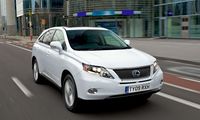Next-Generation Lexus Hybrid Drive Gives RX 450h All-Round Advantage
SEE ALSO: EV-Motoring - Electric Vehicle News Specs and Reviews
SURREY, UNITED KINGDOM – April 8, 2009: The new RX 450h luxury crossover introduces the second generation Lexus Hybrid Drive, a full hybrid system with advanced powertrain technology that delivers an unprecedented combination of fuel economy, low emissions and performance, well beyond the scope of any of its segment rivals.
All the full hybrid system’s components have been revised to achieve dramatically improved efficiency: fuel consumption is reduced by 28 per cent, while at the same time engine power is 10 per cent greater than in the RX 400h. The improvements Lexus has made also contribute to substantially lower emissions, quieter operation and greater driver satisfaction.
Total power output is 295bhp (299 DIN hp), enabling a top speed of 124mph and nought to 62mph acceleration in 7.9 seconds. This performance comes with 44.8mpg combined cycle fuel consumption and 148g/km CO2 emissions, a combination that cannot be matched in the RX 450h’s class, not even by smaller and less powerful 2.0-litre diesel models. This has a direct impact on running costs, for example in a 14 per cent benefit-in-kind company car tax rating – a level typically associated with more modest C-segment models, “eco” specials and other hybrid vehicles, such as the Toyota Prius.
Full Hybrid Drive System Configuration
Lexus Hybrid Drive is
a combined series/parallel full hybrid system that comprises a highly
efficient petrol engine and two powerful electric motors. As a full hybrid
the vehicle can operate on its electric motors or petrol engine alone, or
with a combination of both. Like its predecessor, the RX 400h, the new
model’s second, rear-mounted electric motor provides an intelligent
four-wheel drive capability.
The system combines distinct front and rear driving units, with a power control unit managing their seamless, high-speed interaction.
The front drive unit features a 3.5-litre V6 petrol engine, a powerful electric motor, generator, high performance battery, power control unit (PCU) and a power split device with a planetary gear set to combine and re-allocate power from the engine, electric motors and generator as driving conditions require.
The rear unit is mechanically independent from the front. It provides four-wheel drive by means of a second electric motor, which is activated and continuously adjusted by the Vehicle Dynamics Integrated Management (VDIM) system, working in conjunction with the PCU.
V6 Petrol Engine
The 3.5-litre DOHC petrol engine is based on
that used in the RX 350, but has been adapted specifically for use in the
hybrid powertrain. It produces a maximum 246bhp (249 DIN hp) at 6,000rpm
and 317Nm of torque at 4,800rpm, and features three Lexus hybrid
‘firsts’ to optimise fuel efficiency: Atkinson cycle
combustion, cooled exhaust gas recirculation (EGR) and exhaust heat
recovery (EHR).
In an Atkinson cycle engine the valves close late, delaying compression. This creates a high expansion ratio for less compression, reducing intake and exhaust energy losses and converting combustion energy into engine power more effectively. As a result the exhaust temperature is lower than in conventional engines.
EGR reintroduces cooled exhaust gas into the combustion chamber, further reducing the engine’s operating temperatures. Together these technologies minimise the need for any fuel enrichment to provide a cooling effect and protect the catalytic converter from overheating damage, thereby improving fuel economy and reducing emissions.
The EHR system uses exhaust gas heat to warm the engine coolant at start-up. This reduces the time the engine needs to warm up, allowing it to be shut off earlier for longer electric motor-only operation, particularly in winter.
Power Control Unit
The new power control unit (PCU) is
smaller and weighs less than before and is equipped with a new inverter.
The inverter’s construction allows for cooling on both sides and this
better cooling efficiency has helped increase the power density by 40 per
cent. PCU power losses have also been reduced by more than 10 per cent to
contribute to better fuel economy.
Electric Motors
Although power from the front and rear
electric motors remains the same as it was on the RX 400h, at 165bhp ( 167
DIN hp) and 67bhp (68 DIN hp) respectively, the improved cooling of the PCU
has increased their continuous maximum torque band width. This gives better
performance, in particular from a standing start. The front and rear motors
now deliver maximum torque of 335Nm and 139Nm from zero rpm respectively,
while the range of the front motor’s maximum toque is extended by
9mph and that of the rear by 22mph.
Hybrid Transaxle
Several improvements have been made to the
compact transaxle. An oil slinger has been adopted to reduce drive losses
in the oil pump; an oil cooler has been fitted; low friction bearings have
been installed at key points; and numerous components have been tuned and
re-profiled. These modifications combine to increase torque capacity and
overall transaxle efficiency.
An improved flywheel damper, with a two-stage, torque absorbing damper, absorbs torque fluctuations and also the shock of engine stop and start. This significantly reduces vibration and noise, notably in urban driving when the engine stops and starts most often.
Artificial Intelligence AI-SHIFT control has been adopted for the first time on a hybrid vehicle. The system determines whether the vehicle is travelling up or downhill by comparing vehicle speed with accelerator pedal angle. The transmission then selects the appropriate shift range – from third to sixth – to maintain engine rpm at an optimum speed for either uphill acceleration or downhill engine braking.
Sequential shift-matic control is also available, by selecting ‘S’ in the transmission shift gate. In this mode the driver can select any of six speeds to gain more responsive performance, or to add engine braking assistance.
Three New Driving Modes
The fuel efficiency and performance
are both further improved by the provision of three new driving modes: ECO,
EV and SNOW.



